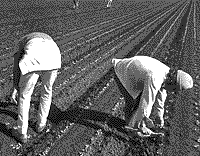

The Death of the Short-Handled Hoe
By Susan Ferris and Ricardo Sandoval
In early 1968, California Rural Legal Assistance lawyer Maurice “Mo” Jourdane was shooting pool in a smoky cantina in Soledad, California, when a small band of farmworkers approached him, a couple of them walking with a rigid gait that spoke of constant pain. The men stopped to talk with Henry Cantu and Hector de la Rosa, Jourdane’s billiards partners, who were outreach workers with CRLA. Cantu then translated a simple challenge from the workers to Jourdane: “If you really want to help the campesino, get rid of el cortito — the short-handled hoe.”
 El Cortito, “the short one,” was a hoe that was only twenty-four inches long, forcing the farmworkers who used it to bend and stoop all day long—a position that often led to lifelong, debilitating back injuries. The pool-room meeting with a handful of its victims led Jourdane to try working in nearby fields for two days. Within weeks of experiencing firsthand the pain eI cortito caused, he and other CRLA attor-neys began a seven-year battle to outlaw the most insidious tool ever used by California agriculture. El Cortito, “the short one,” was a hoe that was only twenty-four inches long, forcing the farmworkers who used it to bend and stoop all day long—a position that often led to lifelong, debilitating back injuries. The pool-room meeting with a handful of its victims led Jourdane to try working in nearby fields for two days. Within weeks of experiencing firsthand the pain eI cortito caused, he and other CRLA attor-neys began a seven-year battle to outlaw the most insidious tool ever used by California agriculture.
For Cesar Chavez, who played a pivotal role in the long drama, there were few greater moments than when el cortito was finally banished from California’s fields in 1975. In his youth, Chavez knew the hoe well, having used it to thin countless rows of lettuce and to weed sugar-beet fields along the Sacramento River. Later he would say he never looked at a head of lettuce in a market without thinking of how laborers had suffered for it from seed to harvest.
“Growers look at human beings as implements. But if they had any consideration for the torture that people go through, they would give up the short-handled hoe,” Cesar said in 1969.
In the late 1960s and 1970s, el cortito was the most potent symbol of all that was wrong with farmwork in California: The tool was unnecessary, and farmers in most other states had long switched to longer hoes. Growers argued that without the control the short hoe offered, thinning and weeding would be mishandled, crop losses would mount, and some farmers would go bankrupt. As he prepared to take on California farmers, Jourdane quizzed many physi-cians—including Cesar Chavez’s back specialist—who said that without a doubt, the hoe was responsible for the debilitating back pain experienced by many of their farmworker patients.
Jourdane was elated when he was finally able in 1972, to tell Chavez that the first formal complaint had been submitted to the state’s Division of Industrial Safety. The lead plaintiff was 46-year-old farmworker Sebastian Carmona. “I came from Texas in 1959 and had never seen a short-handled hoe,” said Carmona during his legal battle. “It surprised me, but I thought I’d be able to handle it because it was smaller [than normal]. The first day, when I needed money for my family, I felt a tightness, but I was okay. The second, third, fourth days. it got worse and worse” —so much so that Carmona would feel a hot pain in his back each time he’d stand erect at the end of a row.
The DIS rejected the attorney’s claim, but the state supreme court overturned that ruling, finding that the tool was a danger to laborers’ health because it could only be used while stooping. A long-handled hoe, the court said, was just as useful. “Getting rid of the hoe felt as good as anything in my career,” said Jourdane, now a retired state judge. “It was flat-out a symbol of oppression—a way to keep control of workers and make them live humbled, stooped-over lives.”
The supreme court ruling failed to move state regulators, however, who in 1975 still had not written rules forbidding the hoe’s use. A frustrated Jourdane called the UFW, which contacted the new governor, Jerry Brown. Under executive pressure from Brown, the bureaucrats finally wrote el cortito out of the fields.
But the tool refused to die. In 1985, as part of a drive to streamline government rules, state safety officials amended the 1975 law banning the hoe, saying workers could be required to use the tool for five minutes each hour. The resulting howl from farm-workers forced new hearings that quickly killed the proposal. Former farmworker Jessie De La Cruz, who once told a grower that with el cortito, “I measured your land inch by inch,” spoke at those hearings and invited state and federal officials to rise and do more than imagine what using a short-handled hoe was like. “I told them.. . just stand up and hold the tips of your shoes and walk up and down this room and see how many times you can do it.”
Susan Ferris and Ricardo Sandoval are the authors of The Fight in the Fields, Cesar Chavez and the Farmworkers Movement, the companion book for the PBS documentary. Susan Ferris is the Cox News Service bureau chief in Mexico City, and Ricardo Sandoval reports from Mexico City for the Dallas Morning News.
|

